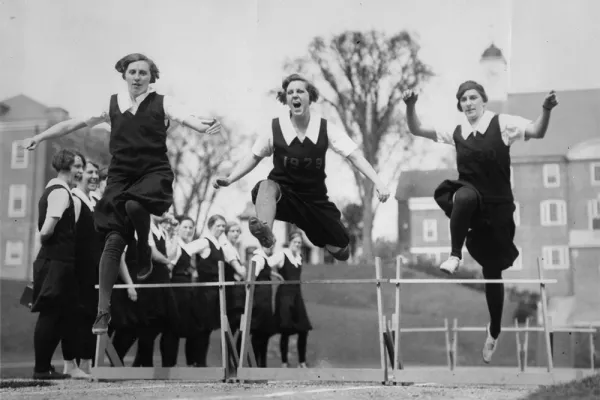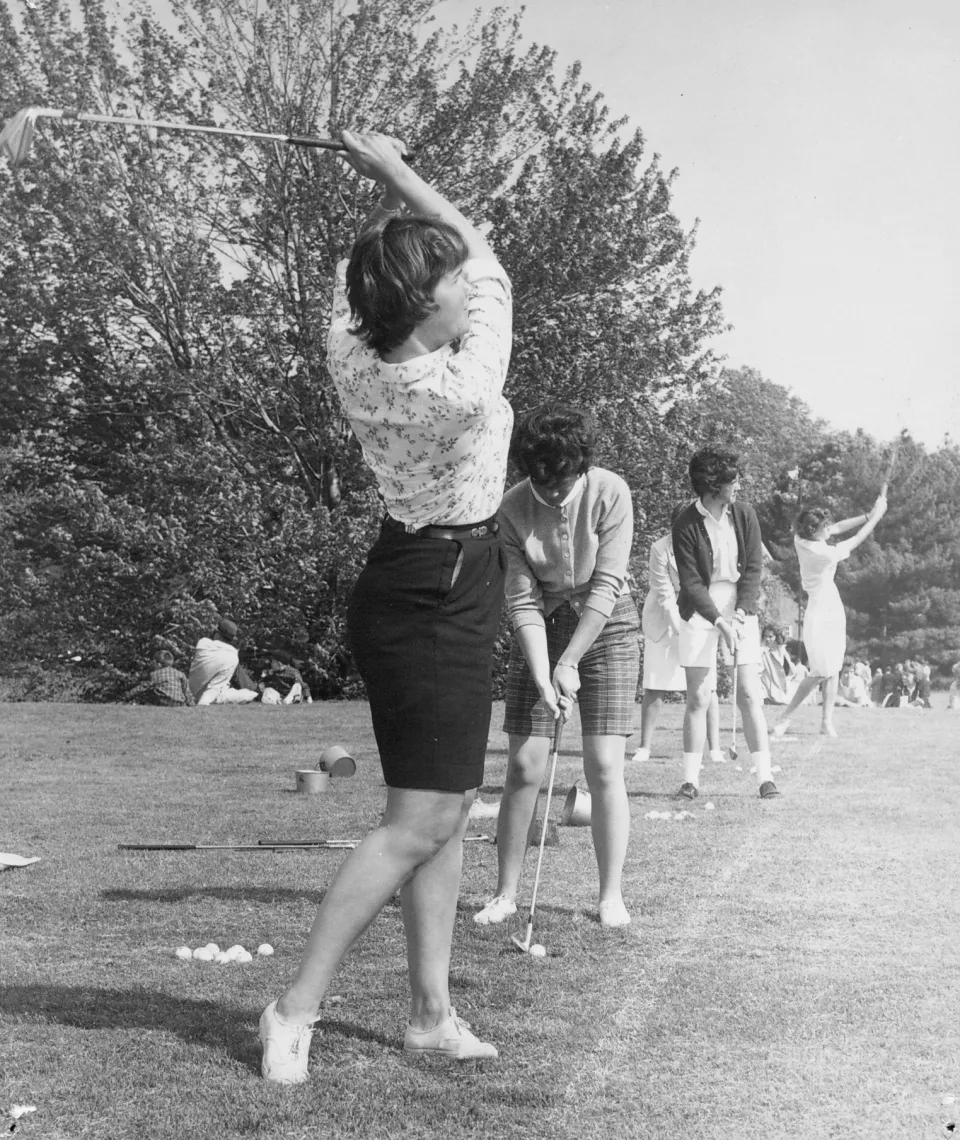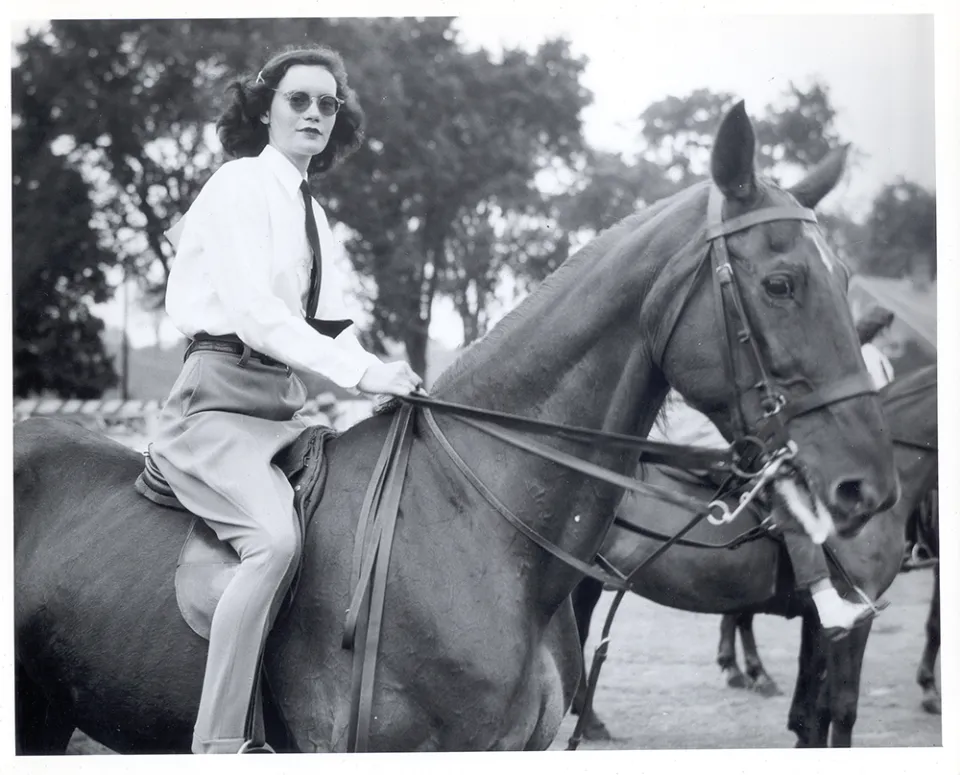The Original Home Court Advantage
Smith Quarterly
Decades ahead of Title IX, Smith put women athletes on center stage
Students hurdle during Field Day in 1929.
Photograph courtesy of Smith College Special Collections
Published August 14, 2025
Long before varsity sports existed, athletics played a huge role in the life of Smith College and laid a foundation for today’s world of intercollegiate athletics.
Now, 53 years after the passage of Title IX—a federal civil rights law that prohibits discrimination based on sex in education programs that receive federal funds—gender equity remains elusive at many coed institutions. But at Smith, women athletes have always taken center stage.
“We were the jocks, but we were women and we all had each other’s backs,” says Jennifer Beindorf ’91, a business consultant who was on the varsity tennis team throughout her four years at Smith. “We all supported each other.”
According to athletics director Kristin Hughes, even the equipment is an advantage—it’s chosen specifically to fit women.
“I loved going into the weight room because that’s where I learned the importance of strength training,” says Beindorf, who still plays competitive tennis. “I was able to go into the weight room and not have to fight over the equipment or get looked at like, ‘What are you doing here?’ I got to weight train with the crew team, the cross-country and track team, and the tennis team. We were the stars of the show, and the spotlight was all on us.”
Hughes says student-athletes who choose Smith understand there are high expectations, so it’s no wonder they go on to excel in their careers.
“We want student-athletes who are really driven to expect success and excellence—like we do in every other part of this campus,” she says. “It’s a disservice to women athletes to expect anything but the best for themselves. We talk about winning. We talk about why it’s important. We talk about why they need to own what they’re good at. Having that kind of presence is obviously going to help their teams, but more importantly, it’s going to [help them] when they leave Smith.”
Students golf during Field Day in 1961.
Photograph courtesy of Smith College Special Collections
This focus continues to drive today’s student-athletes. Jane Loo ’25, who played on the basketball team each of the three years that Smith went to the NCAA Division III Final Four, says knowing that all athletics department resources go to women’s sports played a major role in her decision to attend Smith.
“Because we’re an all-women’s college, we’re able to inspire the next generation of little girls,” says Loo, whose career goal is to become a financial adviser. “We get all the love and support from our community. We have Smith students who drove up to Bowdoin, Maine, to watch us play. This year, some students drove all the way to Virginia for the Final Four. Last year, they drove to Columbus, Ohio. There are alumnae, students, professors, and people from the Northampton community who always come out to support us. I would say a lot of the team’s success is because of them.”
Before varsity sports were introduced at Smith in the 1971–72 academic year, classes competed against each other. After the success of basketball, the college began to incorporate other sports into collegiate life. The first Field Day was held on May 25, 1910, making physical activity a standard part of student life. Over the next few decades, students took part in a variety of sports, including golf, horseback riding, and hurdling. Float Day—in which students decorated canoes and raced around Paradise Pond—was added in 1917 and transitioned to Float Night in 1937.
Some of these traditions have been revived in recent years. Current Field Day activities, which are meant to be light and fun, may involve two student-athletes racing each other through a bouncy house. And on Float Night, Hughes says, “We have our teams race against each other. We open it up to the whole campus. It’s great because you have all these competitive student-athletes. We have music playing. We get a lot of support from Dining Services and Residence Life. We’ve had the president and dean of the college come down and be our officials. It’s great to bring a lot of teams together and do something that is a tip of the hat, if you will, to Smith traditions.”
This heritage of excellence stretches across generations. Beindorf, for example, was selected as Freshman Athlete of the Year and Senior Athlete of the Year across all sports. Her first-year tennis team was inducted into the Smith College Athletics Hall of Fame because it qualified for the NCAA Division III tournament. Having been a competitive tennis player in Florida before college, she was accustomed to being surrounded by boys and men, so Smith’s female-centric environment was affirming.
A student participates in horseback riding during Field Day in 1947. Field Day and Float Night—a similarly athletic tradition that began as Float Day in 1917—have been revived in recent years.
Photograph courtesy of Smith College Special Collections
Her friends at other colleges and universities spoke about the challenges of getting court time or access to the weight room. Even the quality of the food was a topic of discussion.
“We would go to tournaments and compare the food that Smith College sent us off with, like lunch, snacks, and everything; other tennis teams from New England were always kind of marveling at what we had in our coolers,” Beindorf recalls.
Andrea Shang ’10 played squash, which was a varsity sport at Smith, and rugby, a club sport. “I felt like I had the best of both worlds as a Division III student-athlete—being able to have a lot of time to focus on my classes but also getting to focus on these sports that were new to me and develop skills there,” says Shang, who had been a competitive swimmer growing up.
Although she was familiar with rugby, she had never played it. A pop-up table in the campus center and a compelling pitch piqued her interest.
“I showed up for the first day of practice, had a great time, and ended up playing all four years,” Shang says. “I didn’t realize how special it was to [be a student-athlete at a women’s school] until after college. In hindsight, I feel really lucky to have had those opportunities.”
Shang, who earned a doctorate in neuroscience and is now pivoting to data science, says sports gave her many useful life skills, from time management to stress reduction. She still plays competitive squash and is the co-founder of Squash in the City in New York City with Clair Oblamski ’12, who captained both the tennis and squash teams during her senior year.
“It’s a disservice to women athletes to expect anything but the best for themselves. We talk about winning, why it’s important, and why they need to own what they’re good at.”
While most Smith sports are currently thriving, the basketball team is the most prominent on the national stage, having played in the national championship title game the last two years. Sam Intrator, a Smith faculty member since 1999 and the broadcast announcer for Smith basketball home games for more than a decade, credits Hughes and Head Coach Lynn Hersey with the team’s success.
“The gym sells out,” says Intrator, who provides a basketball history lesson in every broadcast. “It is the most raucous, festive, energizing environment. The place just vibrates. It’s the student body, the alumnae, the community. There are hundreds of young girls from all over the community who come to watch ‘their players.’ It’s an incredible community event.”
For Hersey, who was named the 2024 D3hoops.com National Coach of the Year and the 2023 WBCA NCAA Division III National Coach of the Year, each recruit has a story to tell, and a women’s college puts them in the position to tell it. Players who commit to Smith have an exhilarating journey in their four years on campus, she says. “It is about all of us sharing in the experience and having pride in being associated with Smith.”
Livestreaming has been a boon, sparking a surge in support by allowing alums and other members of the Smith community across the country to watch games in real time. Connor Martin, assistant sports information director and associate head coach of the volleyball team, runs Smith Athletics’ social media. “There are comments all the time like, ‘Alum ’78, watching the game.’ It’s really special to see how much they care,” he notes.
Hughes says the support has been “awesome.” When she attends an event, she says, she sees students, alums, and Northamptonites. “We were at the NCAA Rowing National Championship last spring in south Cincinnati, almost to the border of Kentucky, that had Divisions I, II, and III. Smith had by far the biggest contingent. In fact, the commentators who were doing the livestream of the event were saying, ‘Smith College has really shown up.’
Hersey, who has been at Smith since 2007, says the basketball team is a source of great pride for the college. The student-athletes wear Smith on their chests, she says, so they represent all the Smithies across generations who have shared in this unique experience. She has heard from older alums who played basketball before varsity sports existed—and who see themselves in today’s players.
Loo describes Smith Athletics as up and coming. The soccer team, for example, had a high seed in the New England Women’s and Men’s Athletic Conference (NEWMAC) playoffs, and the volleyball team, which had three All-Americans, won the NEWMAC tournament and advanced to the NCAA Division III Regional Championships.
“We’re celebrated here as female student-athletes, and as an athletic group we support each other,” says Loo, echoing Beindorf’s experience from decades prior. “It’s not every day you see a women’s college being No. 2 in the nation.”
Smith continues to impact women’s sports through its master’s program in exercise and sport studies (ESS). This two-year program prepares former collegiate athletes to become college coaches in women’s sports. As part of it, participants serve as assistant coaches at Smith or another local college.
Martin is a graduate of the ESS program. After completing the degree, he worked at coed institutions—where women had to fight for resources—before returning to Smith, which enables the unapologetic pursuit of excellence.
“They have the ability to show off how special they are and put it on the big stage, which we saw with the basketball team,” he says. “They were playing on ESPN+, and the players and coaches were doing interviews with ESPN. Being able to put a women’s college on center stage is really cool.”
A legacy of excellence is depicted on the walls of the athletic complex, where historical photos show generations of Smith women who loved to move, sweat, and win. Hersey says these images make her ponder what the athletic journeys of the women in the photographs were like.
“They’re truly some of the founding women of what is happening today,” she says. “It’s such a motivational part of trying to continue to lead in the ways that we can at Smith. You get your inspiration from those pictures on the wall. It’s truly a unique place to be because of that.”
An award-winning writer, Lois Elfman has examined complex contemporary issues, including gender equity in college sports, for publications such as Women in Higher Education, College Athletics and the Law, and Diverse: Issues In Higher Education.
This article appears in the Summer 2025 issue of the Smith Quarterly.


